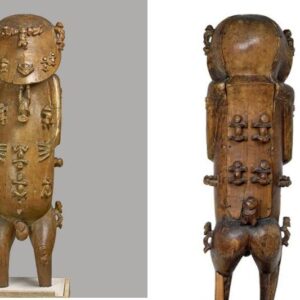The Vettweiss-Froitzheim Dice Tower is an intriguing artifact from the Roman Empire, dating back to the fourth century AD. This small tower, known as a turricula, was used to ensure fair rolls in dice games, a testament to the Romans’ love for gaming and their ingenuity in creating mechanisms to maintain fairness and integrity in their pastimes.
Currently housed in the Rheinisches Landesmuseum of Bonn, the dice tower was discovered in 1985 near the towns of Vettweiss and Froitzheim in Germany. During the Roman era, this region was part of the province of Germania Inferior, a significant area that included major military installations such as Cologne. The dice tower was found on the site of a former Roman villa, suggesting that it belonged to a wealthy Roman household.
The dice tower’s primary function was to randomize dice rolls, preventing cheating in games of chance. Players would drop dice into the top of the tower, and the dice would tumble through a series of internal obstacles before emerging at the bottom. This design ensured that the dice rolls were entirely random, removing any possibility of manipulation by the players. The use of such a device highlights the sophistication of Roman gaming culture and their emphasis on fair play.

The craftsmanship of the Vettweiss-Froitzheim Dice Tower is remarkable. Although the specific materials used in this particular dice tower have not been detailed, similar artifacts from the period were often made from wood, metal, or bone. The design would typically feature intricate carvings and decorations, reflecting the aesthetic values of the time and the status of its owner. The presence of such an object in a Roman villa indicates that dice games were a popular form of entertainment among the Roman elite.
The discovery of the dice tower in a villa near a major military center like Cologne also offers insights into the daily lives of Roman soldiers and civilians in Germania Inferior. Gaming was a common pastime for soldiers, providing a way to relax and bond with their comrades. The proximity of the villa to the military center suggests that the household might have had connections to the military, possibly hosting officers or providing a space for leisure activities.
The location of the find is significant as well. Germania Inferior was a crucial province in the Roman Empire, serving both as a defensive frontier and a hub of economic and cultural activity. The villa’s location near Vettweiss and Froitzheim indicates that it was likely part of a larger network of estates that supported the Roman military and administrative presence in the region. These villas were not only agricultural centers but also played a role in the social and economic integration of the province into the Roman Empire.
The Vettweiss-Froitzheim Dice Tower contributes to our understanding of Roman life in several ways. It demonstrates the importance of gaming in Roman culture and the lengths to which the Romans went to ensure fair play. The artifact also provides a glimpse into the leisure activities of the Roman elite and their connection to the military and economic systems of the empire.
Furthermore, the preservation and display of the dice tower in the Rheinisches Landesmuseum of Bonn allow contemporary audiences to appreciate the ingenuity and craftsmanship of Roman artifacts. Museums play a crucial role in preserving cultural heritage and providing educational opportunities for the public. By showcasing such artifacts, they help to keep the legacy of ancient civilizations alive and accessible.
In conclusion, the Vettweiss-Froitzheim Dice Tower is a fascinating artifact from the fourth century AD that offers valuable insights into Roman gaming culture, craftsmanship, and daily life. Discovered near a former Roman villa in Germania Inferior, it highlights the sophistication of Roman leisure activities and the connections between civilian and military life in the province. Now preserved in the Rheinisches Landesmuseum of Bonn, the dice tower continues to educate and inspire, reflecting the enduring legacy of the Roman Empire.
News
The stunning Temple of Garni, Armenia. Built nearly 2,000 years ago.
Nestled amidst the rugged terrain of Armenia stands a testament to ancient splendor: the stunning Temple of Garni. Built nearly 2,000 years ago, this architectural marvel is…
Reviving the Ancient Abu Simbel Temples: Restoration Efforts in Aswan, Egypt, 1968
In 1968, an extraordinary feat of human endeavor unfolded on the banks of the Nile River in Aswan, Egypt. The ancient Abu Simbel temples, standing for over…
Rare and Ancient Sculpture of Lord Ganesha Carved into the Rocks at Raghunandan Hills (Unakoti)
Nestled amidst the rugged terrain of Raghunandan Hills lies a treasure trove of history and spirituality — the rare and ancient sculpture of Lord Ganesha, immortalized in…
African Architecture: The Unique Construction of Djenné’s Great Mosque
In the heart of Mali lies a testament to human ingenuity and cultural heritage: The Great Mosque of Djenné. Built with indigenous materials, primarily mud brick and…
Bronze Spartan Shield from the Battle of Sphacteria 425 BC Displayed at Athenian Agora Museum
Among the many treasures housed at the Athenian Agora Museum, one artifact stands out for its historical significance and the stories it holds: a bronze Spartan shield,…
Enigmatic Pacific Deity: Captivating Polynesian Artistry
In the heart of Polynesia, amidst the whispers of the Pacific winds and the rhythm of ancient chants, lies a testament to the spiritual and artistic richness…
End of content
No more pages to load











